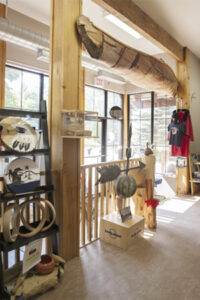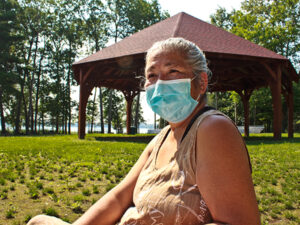The Curve Lake Cultural Centre Working to preserve and maintain First Nation culture since 1989
 The Curve Lake Cultural Centre serves as a focal point for the community and visitors to the area interested in local and regional First Nations culture and the arts by offering instruction, entertainment, and exhibition.
The Curve Lake Cultural Centre serves as a focal point for the community and visitors to the area interested in local and regional First Nations culture and the arts by offering instruction, entertainment, and exhibition.
The work of the Centre is carried out by Cultural Outreach Worker Tracey Taylor – whose responsibilities include sourcing funding, communications and marketing, administrative duties and the creation of workshops – and Cultural Centre Archivist Jack Hoggarth, who, among other things, partners with the knowledge holders to deliver traditional workshops.
Taylor says that the programming at the Centre, which focuses on youth development, can be delivered several ways: students, both local and from as far away as Burlington ON, travel to Curve Lake First Nation; the Cultural Centre does outreach by sending drummers, singers and Elders to the school; or they put the school in touch with Friendship Centres near them.
Programs include:
1. Bus trips to Petroglyphs Provincial Park for a first-hand look at the First Nations rock carvings there. Elementary, high school, post secondary students and private interest groups can make arrangements to participate in this day excursion.
2. Dreamcatcher Workshops
3. Education in both Pre-history and Post Contact.
4. Treaties
5. Tours of Curve Lakes First Nation
6. Cultural Sensitivity Training
 When asked about the importance of the Cultural Centre to the First Nation, Taylor responded, “It is the central hub to preserving Mississauga Ojibway language and culture, and ensuring our history is preserved for generations to come.” She went on to explain that the Centre receives requests from outside organizations regarding cultural protocol, to ensure ceremonies and rituals are performed properly.
When asked about the importance of the Cultural Centre to the First Nation, Taylor responded, “It is the central hub to preserving Mississauga Ojibway language and culture, and ensuring our history is preserved for generations to come.” She went on to explain that the Centre receives requests from outside organizations regarding cultural protocol, to ensure ceremonies and rituals are performed properly.
Inside the Centre can be found community artifacts such as quill work, beading, leather work and basketry; archaeological artifacts including arrowheads, pipes and chairs; books, Curve Lake educational resource materials and history books. Taylor said that some of the artifacts in their collection have come back from generational recipients who wanted to return the items to where they belonged.
Language education is a vital component of the work done by the Centre – this is done by reaching out to the language holders, who participated in a project to translate Robert Munsch’s books into local Curve Lake dialect to bring the local language alive for First Nation children.
With so much to offer, Taylor says of the Cultural Centre “It is our utmost priority to ensure that our history as “Curve Lakers” is maintained.”
For more information on the Curve Lake Cultural Centre,
visit their website: www.curvelakeculturalcentre.ca




